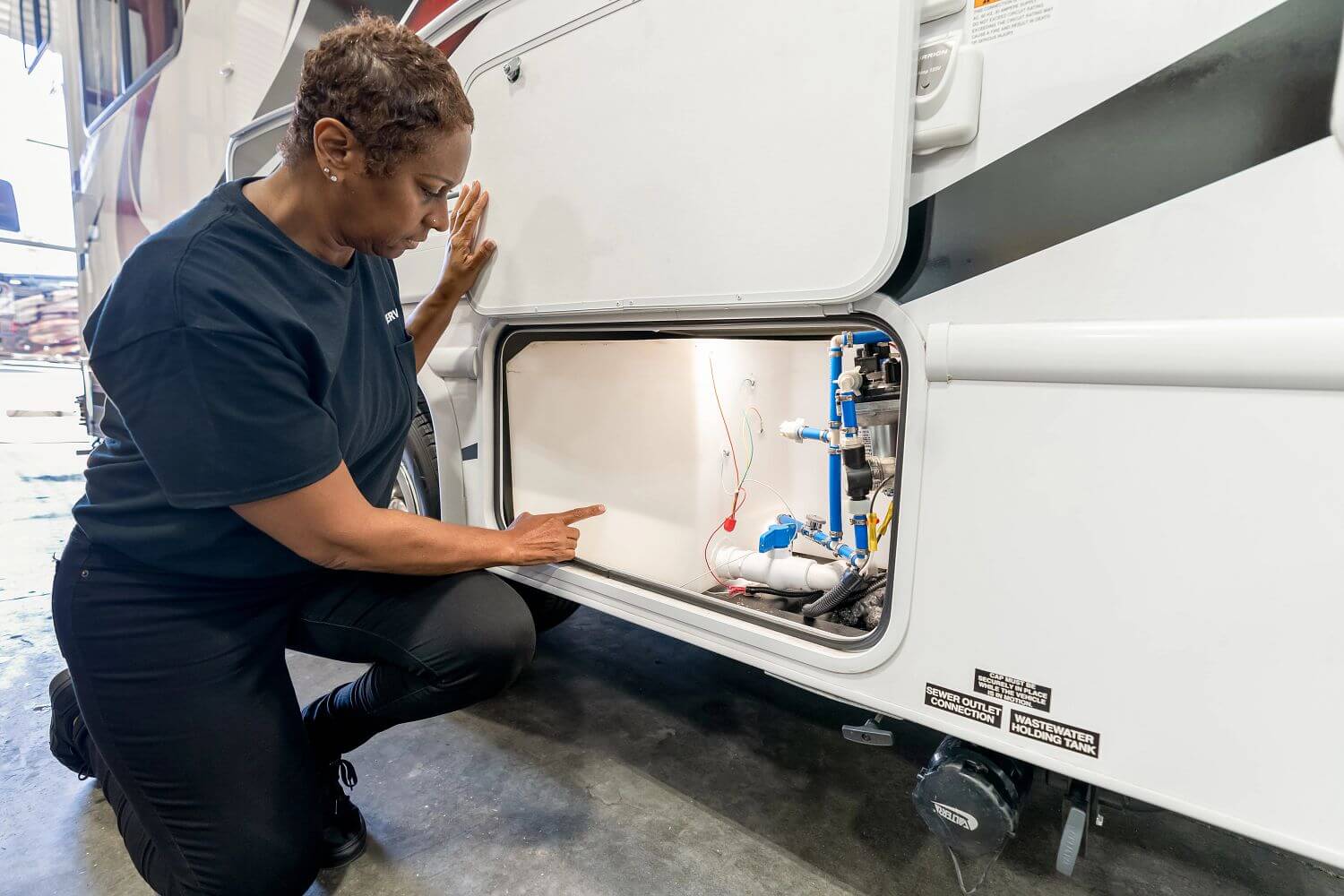Proper maintenance of RV holding tanks is crucial for ensuring a sanitary and pleasant RV experience. Many RV enthusiasts overlook the importance of regular cleaning and maintenance of their black and gray water tanks and often find themselves dealing with unsanitary conditions, foul odors, and expensive repairs.
According to numerous sources, experts recommend cleaning the black tank every time it is dumped, generally when it is 2/3 to 3/4 full to facilitate complete emptying and minimize solid waste accumulation.
On the other hand, the gray water tank also needs regular cleaning, ideally after every few trips depending on usage. This article delves into the best practices and recommended cleaning frequencies for RV holding tanks according to expert sources.
We will also provide you with additional insights to help you keep your RV clean and ready for your next adventure.
Table of Contents
- Cleaning Frequency for RV Holding Tanks
- Effective Methods for Cleaning RV Holding Tanks
- Why Regular Cleaning is Crucial
- Best Practices for RV Holding Tanks Maintenance
- Tips for Winter Maintenance of RV Holding Tanks
- FAQs about RV Holding Tank Cleaning
Cleaning Frequency for RV Holding Tanks
Cleaning your RV’s holding tanks is essential for maintaining hygiene and ensuring your RV continues to function effectively. The black water tank, which collects waste from the toilet, needs to be addressed with proper frequency to prevent odor buildup and clogs.
According to various experts, such as those highlighted in expert RV communities, it is recommended to clean the black water tank every time it is dumped, specifically when it reaches 2/3 to 3/4 full.
This facilitates complete emptying and minimizes solid waste accumulation.
As for the gray water tank, it should also be cleaned regularly. Ideally, RVers should clean it after every few trips, depending on usage, with monthly cleaning recommended during peak seasons.
In winter, cleaning every two months suffices, according to some RV communities.
Routine cleaning is also essential as it helps ensure that the tank sensors operate efficiently over time.
The table above summarizes the cleaning frequencies for both black and gray water tanks, elucidating how usage and seasonal considerations influence these schedules. Maintaining a regular cleaning routine helps prevent issues such as blockages and unpleasant odors.
- Clean the black water tank each time it is dumped for minimal buildup.
- Clean the gray water tank regularly based on trips and usage.
- Monthly cleaning is ideal during peak seasons; bi-monthly suffices in winter.
Effective Methods for Cleaning RV Holding Tanks
There are several effective methods to clean RV holding tanks, ranging from DIY strategies to professional services. For DIY cleaning, many RVers utilize products like biodegradable soaps or specialized tank cleaning treatments designed specifically for RV holding systems.
One of the more popular techniques is using hydro-jetting, where a high-pressure water system is employed to thoroughly clean tanks by dislodging deposits and clogs.
Tools such as tank cleaning wands also play an integral role in routine maintenance efforts. When using chemical cleaning agents, it is essential to avoid harsh substances like bleach or ammonia, as they may degrade seals and plastics within the RV’s plumbing systems.
RV manufacturers generally recommend using mild, enzyme-based cleaning solutions that effectively degrade solids and maintain hygienic conditions.
The table above highlights various cleaning methods including their pros and cons, providing RV owners with options that best fit their circumstances and budgets. Opting for professional cleaning can be especially useful for those who may experience complex clogs or odors that DIY methods cannot resolve.
- Utilize DIY solutions for cost-effective cleaning.
- Consider hydro-jetting for thorough cleaning of stubborn deposits.
- Professional cleaning provides expert care but may incur higher costs.
Why Regular Cleaning is Crucial
Regular cleaning of RV holding tanks is vital not just for preventing foul odors, but also to ensure that holding tanks function effectively. As noted by experts in RV maintenance, failing to clean tanks regularly can lead to a buildup of solids, thus obstructing sensors and causing inaccurate readings regarding tank levels.
Over time, neglect can result in overflows or clogs, which may necessitate costly repairs or professional cleaning services.
Additionally, using the right cleaning method not only prevents these issues but also maintains the health of the plumbing system, thus enhancing durability and possibly increasing resale value. Ensuring clean tanks can contribute to a more pleasant RV experience for travelers, allowing for greater enjoyment and comfort on the road.
- Regular cleaning prevents solid buildup and sensor obstruction.
- Neglect may lead to clogs and expensive repairs.
- Clean tanks enhance the overall RV experience for travelers.
Best Practices for RV Holding Tanks Maintenance
Effective maintenance of RV holding tanks involves more than cleaning alone. To ensure optimal function and condition, it is essential to adopt best practices such as using high-quality RV toilet paper that dissolves easily in water to prevent clogs; avoid flushing non-biodegradable items; and add a few gallons of water to the black tank before usage to keep solids suspended.
For RVers with black tank sensors, they need to be vigilant, as buildup on sensors can mislead readings.
Therefore, routine cleaning will help maintain accuracy and functionality.
Choosing the Right RV Toilet Paper
A common source of clogs in RV toilets is the toilet paper used. Regular household toilet paper is slower to dissolve and can lead to severe clogs.
Hence, select RV-specific or ultra-dissolvable toilet papers to ensure they break down quickly in your tanks, minimizing the risk of blockages.
Effective Use of Rinse Systems
Most modern RVs come equipped with flush mechanisms or rinse systems, which should be effectively utilized after dumping the black tank. This practice helps dislodge and clear away any remaining solids, thus maintaining cleaner tanks.
If your RV does not have a rinse system, consider getting a cleaning wand or similar device to help facilitate manual rinsing from the toilet.
Maintaining Tank Sensors
Regular cleaning helps ensure that the tank sensors provide accurate readings. If your sensors are consistently failing to reflect tank levels, check the buildup on the sensors and clean them using appropriate methods.
Regular maintenance prevents sensor misreadings and promotes peace of mind regarding tank adequacy.
- Select high-quality RV toilet paper for better dissolution.
- Utilize rinse systems post-dump for thorough cleaning.
- Routine maintenance of sensors ensures accurate readings.
Tips for Winter Maintenance of RV Holding Tanks
Winterizing your RV holding tanks is essential to avoid freezing and potential damage. This process involves emptying and sanitizing your tanks before winter storage, which protects them from odors due to stagnant waste and ensures they are ready for the next travel season.
Additionally, adding RV antifreeze to plumbing lines helps in preventing freezing.
Regular checks during inactivity help identify potential issues early. It’s a wise decision to consult your RV’s manual for any specific winterization techniques that could extend the lifespan of the tanks and plumbing system.
Preparing Tanks for Winter
Before storing your RV for winter, empty and clean both holding tanks. Add RV antifreeze to the plumbing lines to prevent icicles from forming and potentially damaging the system.
This is crucial, especially for areas where temperatures regularly drop below freezing.
Checking Tank Condition During Inactivity
Even when inactive, periodically inspect the tanks for any leaks or signs of damage. Unattended tanks can lead to major repair costs if any issues go undetected until the next use.
Using RV Antifreeze Safely
Choose a non-toxic, RV-safe antifreeze that will adequately protect your plumbing system during winter months. Ensure to follow the product instructions closely for safety and effectiveness.
- Empty and sanitize tanks before winter storage.
- Inspect tanks regularly during inactivity for potential damage.
- Use RV-safe antifreeze to protect plumbing from freezing.
FAQs about RV Holding Tank Cleaning
How often should I clean my fresh water tank?
Your RV’s fresh water tank should be sanitized at least once every six months, or before setting off on a long trip. Particular circumstances may call for further cleans, such as before or after storing your RV, or after using water from questionable sources.
This helps prevent bacterial growth, and ensures that the water remains safe for consumption.
What happens if I don’t clean my black tank regularly?
If you neglect to clean your black water tank, it may lead to odor buildup, blockages, and expensive repairs. Solid waste can accumulate and dry on the tank walls, causing overflows, clogs in the plumbing system, and inaccurate sensor readings, turning a simple clean into a significant issue.
Can I mix different cleaning chemicals?
It is not recommended to mix different cleaning chemicals, especially bleach with other solutions, as this can create toxic reactions or render the chemicals ineffective. Always consult the labels of any cleaning agents used for compatibility and follow manufacturer guidelines for optimal safety and effectiveness.
What type of toilet paper should I use in my RV?
Using toilet paper specifically designed for RV use is crucial in preventing clogs and maintaining your black water tank. Opt for biodegradable or ultra-dissolvable toilet paper to ensure that it breaks down quickly and efficiently in your tank, reducing the risk of blockages.
Do I need professional help for tank cleaning?
While many RV owners can handle basic tank cleaning themselves, some situations may require professional assistance. If you encounter persistent odors, clogs, or buildup that you can’t remove yourself, calling a professional might be necessary to ensure your tanks are properly cleaned and maintained.
Conclusion
In summary, maintaining the holding tanks in your RV is not a task to be neglected. By adhering to recommended cleaning frequencies and employing effective methods, RVers can avoid unpleasant situations and ensure their systems function smoothly.
Understanding the importance of maintaining individual black and gray water tanks, as well as the freshwater tank, will contribute to a more enjoyable RV experience.
As RV enthusiasts hit the road, staying informed and proactive about their tank maintenance will enable many more adventures without the stress that comes from neglecting these vital components.

